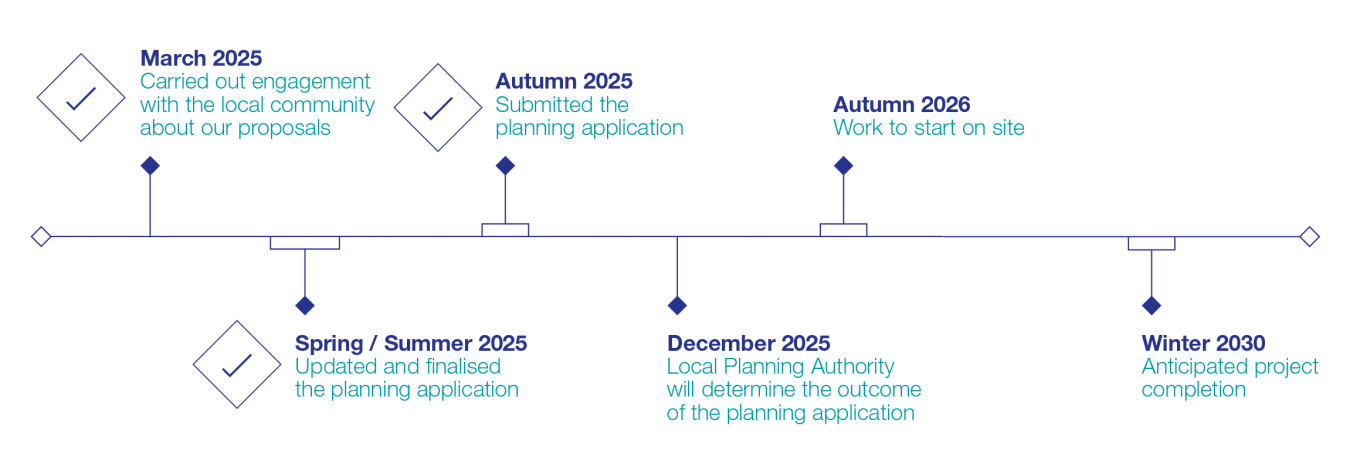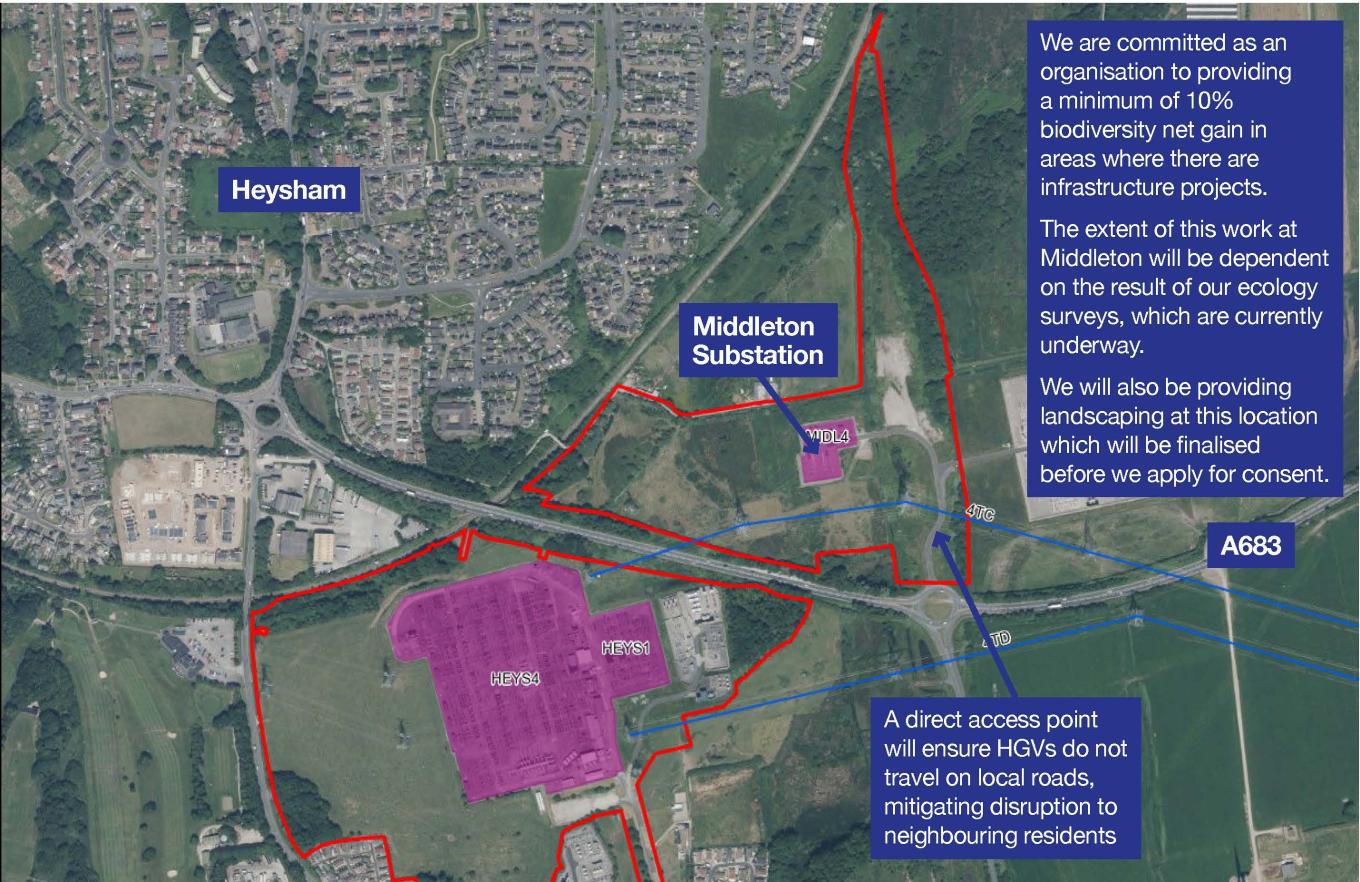National Grid Electricity Transmission (NGET) has submitted a planning application for an extension to Middleton Substation, near Heysham.
Latest update
We have now submitted a planning application to Lancaster City Council. The application can be found on the Lancaster City Council’s planning portal here or by searching this reference number: 25/01055/FUL.
Since engaging with the community, and following a review of our plans, we have proposed some changes to our application, which are outlined below. These changes have been made to reduce the environmental impact of the proposed substation extension.
Officers at the council will now assess our application, and work with the project team to review the reports and assessments that have been submitted.
The proposals
The way we generate electricity in the UK is changing rapidly, as we transition to cheaper, cleaner and more secure forms of homegrown energy.
We need to make changes to the network of overhead lines, pylons, cables and other infrastructure that transport electricity around the country, so that everyone has access to the clean electricity from these new renewable sources.
You can find out more information here on the proposed extension at Middleton Substation, located around 5 km from Lancaster on the outskirts of Heysham.
Extending Middleton substation
Several new projects have been brought forward by customers near Middleton, which require connections to the grid. As we’re legally obligated to fulfil any connection requests, this extension will help meet demand in the area and ensure Middleton Substation remains able to ensure resilient and efficient energy transmission for years to come.
Planning application
Thank you to everyone who took the time to engage with our team on our proposals to extend the existing 400 kilovolt (kV) substation at Middleton.
In March 2025, we carried out programme of community engagement to inform the local community of our proposals to extend the existing substation at Middleton, Heysham. This included engagement with local representatives, an online webinar and an in-person event at Heysham Jubilee Institute.
We have since made some changes to our plans. The design changes have been made to reduce the environmental impact of the extended substation by allowing us to use improved equipment at the substation, in turn avoiding the need to use greenhouse gases for insulation.
To facilitate this, rather than extending the existing gas insulated switchgear building (GIS), we are proposing:
- a new standalone GIS building 10 metres (m) to the west of the existing GIS hall, slightly larger than originally proposed (46.2m x 20.2m)
- small changes to the redline boundary to accommodate the construction equipment needed to build the GIS hall and a temporary access road
- an extended access road to the western boundary of the site to allow easier access into the site once the temporary access road is removed.
We are proposing that the GIS hall, which would be 2.2 m taller than the existing building, would be built using the same material as the existing hall, to minimise its visual impact. Existing landscaping around the site boundary will also continue to provide visual screening.
You can find our full application here or by searching Lancaster City Council’s planning portal using this reference number: 25/01055/FUL.
Officers at the council will now assess our application, and work with the project team to review the reports and assessments that have been submitted.
Following these steps, the council will then determine the application. This is either done by officers, under delegated powers or at a meeting of the planning committee.
Our anticipated timeline for the project, if approved, is illustrated below.
Project timeline

Community benefits
In March 2025, the Government published new guidance setting out how communities hosting new or upgraded electricity transmission infrastructure should be rewarded for doing so.
We’re pleased to confirm that the work we are proposing at Middleton Substation qualifies under this new guidance. This means that if our application for Middleton Substation is approved, £530,000 will be available to invest in projects that benefit local people.
This funding replaces – and offers a significantly increased level of investment than – the Community Grant Programme that we introduced at our public information events in March 2025.
We look forward to working with local residents, charities and community groups, and elected representatives to understand your priorities and how such funding could be spent to deliver long lasting benefits.
Contact us
If you have any questions, get in touch with our team by:
- Emailing: [email protected]
- Calling: 0808 303 4641
Documents
Contact us
If you have any questions, get in touch with our team by:
Emailing: [email protected]
Calling: 0808 303 4641
National Grid sits at the heart of Britain’s energy system, connecting millions of people and businesses to the energy they use every day. We bring energy to life – in the heat, light and power we bring to our customer’s homes and businesses; in the way that we support our communities and help them to grow; and in the way we show up in the world. It’s our vision to be at the heart of a clean, fair and affordable energy future.
National Grid is a group of companies, and one of those companies, National Grid Electricity Transmission (NGET), owns, builds and maintains the high voltage network in England and Wales. It is NGET who is developing plans for the Navenby Substation project.
Within the National Grid Group there are other distinctly separate legal entities, each with their individual responsibilities and roles. More information about National Grid can be found on the ‘about us’ section of National Grid’s website.
NGET owns, builds and maintains the high-voltage electricity transmission network in England and Wales. This network operates primarily at 400,000 volts (400kV) and 275,000 volts (275kV).
The highly strategic location of the site, close to the A683, allows vehicles to access the site directly without travelling through residential areas and on local roads, which will significantly mitigate disruption.
Vehicle movements will be largest during the construction period. During operation, vehicle movements to and from the site will be limited to only maintenance at the substation, typically significantly fewer than movements during construction.

We are in the process of completing ecological surveys, and their outcomes will be made publicly available upon the submission of our planning application. National Grid will work with Officers to offset any impact to sensitive species on site, and to mitigate any impact to the nearby Heysham Moss Site of Special Scientific Interest.
We’re finalising our Operational Noise and Vibration Assessments, to understand the potential noise and vibration impact during the development process on local residents. These impacts must be kept under legal limits, and we will work with officers at Lancaster City Council to ensure that any necessary mitigation measures are identified and implemented.
Years of study and research have indicated that, as long as exposure to EMFs is kept under conservative guideline limits, there is no evidence of any risk to health for those living nearby. All National Grid equipment and operations comply fully with local exposure limits, and typical exposure to magnetic fields is a fraction below guideline limits.
We have now submitted a planning application to Lancaster City Council. The application can be found on the Lancaster City Council’s planning portal here or by searching this reference number: 25/01055/FUL. Officers at the council will now assess our application, and work with the project team to review the reports and assessments that have been submitted.